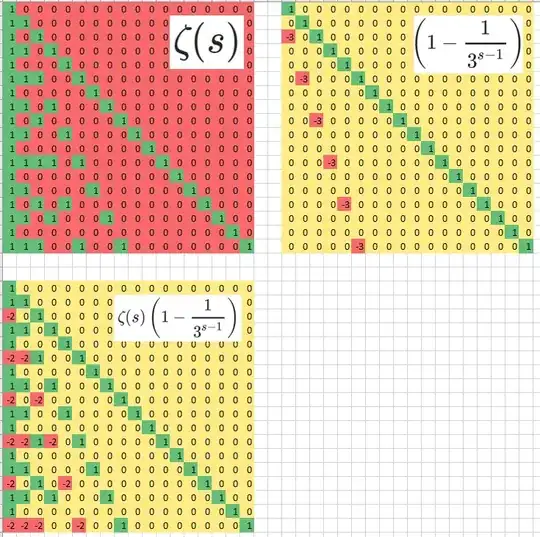While your particular proof of convergence is incomplete, it is fortunately not too far off; we just need to amplify slightly in order to make the argument fully explicit. Here’s a general theorem:
Theorem. (Finite grouping and vanishing implies series convergence)
Let $\{a_n\}_{n=1}^{\infty}$ be any sequence of complex numbers (or really any normed vector space), and let $P=\bigcup_{k=1}^{\infty}P_k$ be a partition of $\Bbb{N}$, in ‘ascending order’ (meaning $\max P_k<\min P_{k+1}$) such that $M:=\sup\limits_{k\geq 1}|P_k|<\infty$ (i.e there is an upper bound on the length of the $P_k$’s). If $\sum\limits_{k=1}^{\infty}\left(\sum\limits_{n\in P_k}a_n\right)$ converges and $\lim\limits_{n\to\infty}a_n=0$, then $\sum\limits_{n=1}^{\infty}a_n$ converges and equals $\sum\limits_{k=1}^{\infty}\left(\sum\limits_{n\in P_k}a_n\right)$.
To prove the theorem, note that for any $n\in\Bbb{N}$, there is a unique $k_n\in\Bbb{N}$ such that $n\in P_{k_n}$. Then, we have
\begin{align}
\sum_{i=1}^{k_n}\left(\sum_{m\in P_i}a_m\right)= \sum_{j=1}^na_j+\sum_{m\in P_{k_n}\setminus\{1,\dots, n\}}a_m.
\end{align}
The second term on the RHS contains at most $M$ many terms, so if we keep in mind that as $n\to\infty$, we have $k_n\to\infty$ as well, then since $\lim\limits_{j\to\infty}a_j= 0$, we have that the second term vanishes as $n\to\infty$, hence proving the theorem.
In your case, you will apply this to $P_k=\{3k-2,3k-1,3k\}$, i.e groups of $3$. I realize that notationally, the above proof may have been very terse, so I’ll repeat it again in this special case. Given any $n\in\Bbb{N}$, we can find a unique integer $p_n\in\Bbb{N}$ such that $n\in \{3p_n-2,3p_n-1,3p_n\}$. So,
\begin{align}
\sum_{k=1}^{p_n}(a_{3k-2}+a_{3k-1}+a_{3k})&=
(a_1+a_2+a_3)+\dots +(a_{3p_n-2}+a_{3p_n-1}+a_{3p_n})\\
&=(a_1+\dots +a_n)+\underbrace{(a_{n+1}+\dots +a_{3p_n})}_{\epsilon_n}\\
&=\sum_{j=1}^na_j+\epsilon_n
\end{align}
Note that if $n$ happens to be $3p_n-2$, then in the ‘error’ term $\epsilon_n$, we have two terms $a_{3p_n-1}+a_{3p_n}$. If $n$ happens to be $3p_n-1$, then we have one term, namely $a_{3p_n}$. If $n=a_{3p_n}$, then $\epsilon=0$ has no terms.
So, clearly, $\epsilon_n$ is bounded by $|a_{3p_n-2}|+|a_{3p_n-1}|+|a_{3p_n}|$, which vanishes as $n\to\infty$, since $p_n\to\infty$ as well. Therefore, taking the limit $n\to\infty$, and noting that by hypothesis, the LHS has a limit, we see that $\sum_{j=1}^{\infty}a_j$ exists and equals $\sum_{k=1}^{\infty}\left(a_{3k-2}+a_{3k-1}+a_{3k}\right)$. Hopefully this clarifies the terse proof above.
One thing I should remark is that for this theorem, it is necessary to have the hypothesis $a_n\to 0$, because otherwise $a_n=(-1)^n$ provides us with a counterexample if we group by twos vs if we skip the first and then group by twos again.
We can now apply this to your question. You have already shown that by grouping in threes, you get something convergent (my earlier comment that this shows absolute convergence of the original series was wrong, so I deleted it). Also, in your case $|a_n|\leq \frac{2}{n}\to 0$ as $n\to\infty$. Therefore, by the theorem, the full series converges (and to the same value).
However, for actually evaluating the series, it is not any easier to evaluate your ‘grouped series’. Instead, consider the power series $f(x)=\sum_{n=1}^{\infty}a_nx^n$ defined for $|x|<1$. When $|x|<1$, we have wonderful convergence properties, and we can manipulate things freely as shown in @Ian’s answer, utilizing the power series for logarithms to deduce that for all $|x|<1$,
\begin{align}
f(x)&=\log(1+x+x^2).
\end{align}
Since the series $\sum_{n=1}^{\infty}a_n$ converges (as we have argued above) Abel’s theorem now tells us that
\begin{align}
\sum_{n=1}^{\infty}a_n=\lim_{x\to 1^-}f(x)=\lim_{x\to 1^-}\log(1+x+x^2)=\log 3.
\end{align}
Note that for the usual alternating series $S=1-\frac{1}{2}+\frac{1}{3}-\frac{1}{4}\cdots$, the usual way of proving that the series converges is by invoking the alternating series test. However, with the above theorem in mind (which does not require monotonicity of the sequence) we can group in twos to say $\sum_{k=1}^{\infty}\left(\frac{1}{2k-1}-\frac{1}{2k}\right)=\sum_{k=1}^{\infty}\frac{1}{2k(2k-1)}$ which converges by comparison with $\frac{1}{k^2}$, and so by the theorem I proved above, the alternating series $S$ converges. Its value can then be calculated using the Taylor expansion of logarithms and invoking Abel’s theorem (of course other proofs are available).
